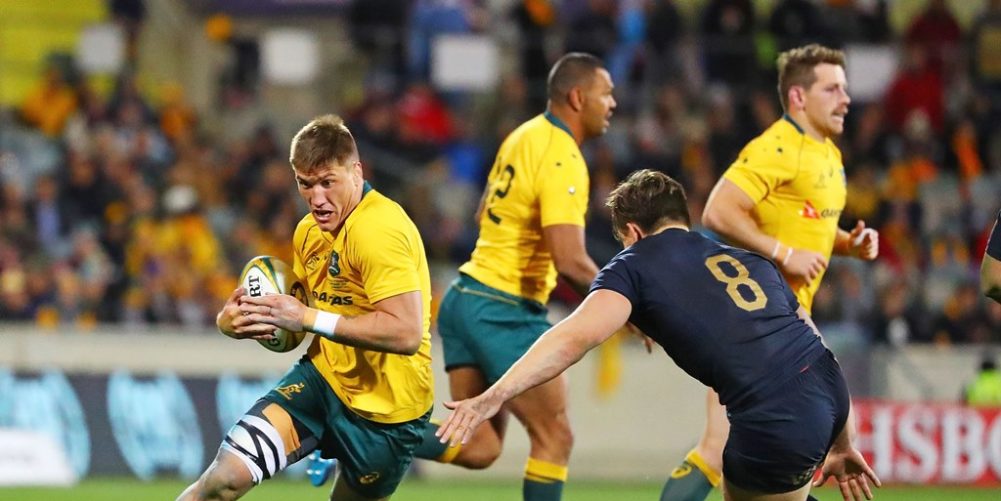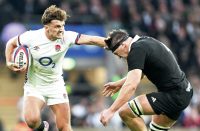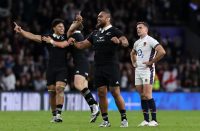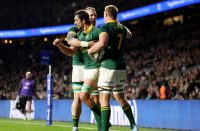(Photo: Getty Images)
By Nick Cain
Payback. It’s 4-0 to ‘English’ Eddie Jones on Michael Cheika’s watch, and that bashing by the Poms will be more toxic to the Wallaby coach than the bite of a brown snake – the most venomous serpent on the Australian continent.
The fact that three of those victories were inflicted in a first lost series to the English on home soil 18 months ago means that Cheika’s only antidote is to leave Jones and his new Red Rose mates feeling some of the same pain this autumn.
That dream of revenge over his old Randwick friend – and new international foe – is why a win at Twickenham on Saturday will be at the top of Cheika’s autumn list. That motivation, combined with more settled selection and a team with potent attacking ability is why Australia may well be the most dangerous proposition England face not just this autumn, but this season.
Australia probably got ahead of themselves after being runners-up to New Zealand in the 2015 World Cup, and in the summer of 2016 a revamped England side under Jones reminded them just how transient elite status is for anyone who does not adhere to the All Black mantra of constant improvement.
This season, following a dispiriting 54-34 hammering by New Zealand in Sydney, Australia appear to have turned a corner. Although the response was not immediate, because they lost the return narrowly to New Zealand in Dunedin, the improvement has steadily gathered momentum with two draws against South Africa and two wins over Argentina in the Rugby Championship.
Then, three weeks ago, came the eureka moment for Cheika’s Wallabies. Their advance was underlined when they followed in the footsteps of the 2017 Lions by inflicting the second loss of the year on the double world champions, beating them 23-18 in their Bledisloe Cup encounter in Brisbane.
That victory not only ended a seven match losing streak against New Zealand, it gave Cheika’s side the most valuable commodity in Test rugby – confidence.
Australia are a better side than they were in the summer of 2016, and they have arrived in Europe surfing the crest of a wave after an unbeaten five-match streak. Their growing confidence was reflected in captain Michael Hooper’s pre-match certainty before the win in Brisbane that there would be nothing between his side and the All Blacks.
The openside flanker said: “It’s going to go down to the 80 tonight.” That belief was reinforced by Hooper’s next comment that, “we’re starting to see the benefits of combinations working together.”
The chopping-and-changing in selection that characterised Cheika’s second season in the job has been replaced by the greater familiarity that Hooper alluded to. After the win over New Zealand Michael Lynagh summed up the mood-swing neatly when the former Wallaby fly-half said: “Cheika is getting settled, as well as the team.”
With Australia having limbered up with a nine tries 63-30 win over Japan in Yokohama before arriving in the UK to play Wales, England and Scotland on consecutive November weekends, that teamwork – and, crucially, squad depth – is likely to be tested fully.
That they cannot rely on the match-winning incursions of their brilliant full-back Israel Folau – who has been granted a recharge-the-batteries sabbatical – will not make their task of returning home with three more wins any easier. The same is true of the loss of Jack Dempsey, the Wallaby find of the season, with the all-action blindside ruled out of the autumn tour with a torn hamstring tendon.
However, despite that depletion, and the exodus of players of the calibre of Will Skelton (Saracens), James Horwill (Harlequins), James O’Connor (Sale Sharks), Ben Mowen (Pau) and Christian Leali’ifano (Ulster), there is a new-found optimism that this Australia squad is not just back on track, but has arrived in Europe full of intent to build a head of steam towards the 2019 World Cup.
That optimism survived a potential derailing this week when it was announced that their seasoned hooker Tatafu Polota-Nau will join Leicester after the tour. Hooper, who is his teammate and skipper at the NSW Waratahs as well as the Wallabies, managed the loss of such a significant senior pro by accentuating positives over negatives.
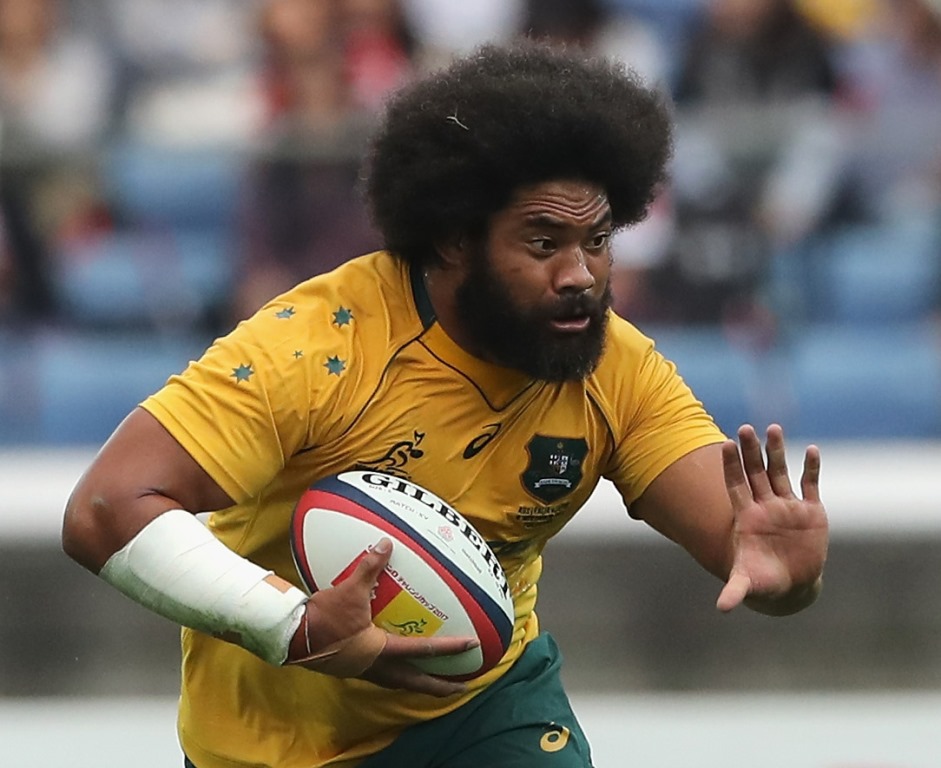
Hooper said he was sure that Australia’s overseas dispensation for 60 cap-plus players like Polota-Nau meant that he would play a full part in their World Cup campaign despite his move to the East Midlands.
Polota-Nau, 32, is one of the main reasons why the Australian scrum is no longer considered to be a soft touch. His power and physical presence has earned him the reputation of being one of the best scrummaging hookers in the game, and he is also a highly effective carrier at close quarters. That makes the idea that England’s recent scrum session with Wales will have the Wallabies quaking a little fanciful.
It is worth highlighting too that the Australian first choice front row, which has loose-head Scott Sio and tight-head Sekope Kepu propping either side of Polota-Nau, is as experienced – and arguably more dynamic in the loose – than its England counterparts.
Going into the Autumn series Polota-Nau had 79 caps compared to Dylan Hartley’s 86, while Kepu had 88 caps to Dan Cole’s 74, and Sio had 40 to Mako Vunipola‘s 42.
In addition, Kepu has a turn of pace for a prop that rivals the absent Kyle Sinckler, while Sio is another powerful carrier. He may not quite match Mako Vunipola for sheer work-rate, but he does for mobility.
Polota-Nau has, like Hartley, eradicated the line-out yips that saw Stephen Moore get ahead of him, and at line-out and scrum neither side appears to have a clear advantage. It is in the loose that Hartley suffers by comparison – and it will be instructive to see if England’s Lions Test hooker, Jamie George, is eventually given a big-game start by Jones this autumn.
The back five of both packs also look well matched, especially in the second row where Australia’s 80-cap old hand Rob Simmons and the raw-boned Adam Coleman face-off against the pair that Jones picks from his lock stockpile of Maro Itoje, George Kruis, Courtney Lawes and Joe Launchbury.
Where Cheika will be banking on stealing a march is in the back row, where the England trio picked against Argentina of Chris Robshaw, Sam Underhill and Nathan Hughes looked too one-paced.
While Hughes can shift when he gets into top gear, he does not have explosive acceleration, whereas the Wallaby strategy of playing two fast, dynamic opensides continues with Hooper and Sean McMahon, even though the latter has been wearing the No.8 jersey.

The pattern was established when David Pocock (currently on sabbatical in Japan) dove-tailed with Hooper, with Cheika opting for the attributes of speed, both in support play and in challenging for the ball on the ground, ahead of potential size deficit at the line-out and scrum. However, if that becomes an issue the Wallaby coach has the option of Ned Hanigan, the young blindside who started against Wales, or the solid 50-cap No.8/blindside Ben McCalman.
Hooper and McMahon were linchpins in the win over New Zealand – including a Hooper line-break to set up Folau’s try in that match – and, whichever England back row Jones opts for, its ability to slow down Australia’s ball legitimately at the breakdown will be crucial. It also puts a huge onus of responsibility on his most inexperienced player, openside Sam Underhill.
Should Australia succeed in getting quick ball they have a back line built to exploit it – and no-one more so than Kurtley Beale. The Australian play-maker was identified by Jones in a recent interview as the player that poses the greatest threat to England on Saturday.
Jones said that his experience of playing in the Premiership for a season with Wasps had benefited both Beale and the Wallabies. “He’s learned a lot from Wasps, and I’m not sure we should thank them for it! It’s matured his game. He’s had to come and play in England in tough conditions – the sun’s not shining, the pitch isn’t hard – and he’s really learned to bring his best foot forward.”
Jones added in the interview with Sky Sports: “He’s gone back to Australia and really played superbly. Australia are very dangerous with Kurtley there.”
Beale’s selection at full-back suits his talent as a play-maker, especially when it comes to picking devastating attacking lines. It makes him an ideal foil for the muscular Fijian-origin centre pairing of Samu Kerevi and Tevita Kuridrani, while another former Fijian, NRL wing Marika Koroibete, already looks like a handy addition to Cheika’s line-up.
The other wing, Reece Hodge, also has a Beale-like touch of the all-singing all-dancing about him as he can play centre and fly-half, as well as kick long-range penalties.
Hodge’s running action may be more lurcher than racehorse – but when you come off your wing and cut through defences like he does, his team-mates will not give a hang if he gets ‘nul points’ for style.
What this Wallaby backline has is speed and power – and also superior size compared to the English backs. Hodge (6ft 3ins), Kuridrani (6ft 4ins), Kerevi (6ft 1ins) and Koroibete (5ft 11ins) are bigger men than Anthony Watson, Henry Slade, Owen Farrell and Elliot Daly, meaning that their English counterparts simply cannot afford to fall off tackles.
Which brings us to the Wallaby orchestrators at 9 and 10, Will Genia and Bernard Foley. Genia looked a spent force when he arrived at Stade Francais, but he has returned to Australia revitalised after his stint in Europe. Although he appears to have been around forever the scrum-half is still only 29, and his elusive running around the fringes has re-emerged to rival that of Ben Youngs, giving Australia an important added component in attack.
Foley may not be in Farrell’s league as a pressure goal-kicker, but the Wallaby fly-half is a slick distributor who plays in the teeth of the defensive line and has the acceleration to punish any lapses.
Those who underestimate Foley usually pay for it, and a significant factor in England’s 2016 summer tour whitewash was down to the pressure George Ford, Farrell and James Haskell put on the Wallaby fly-half.
Australia have a score to settle, and England are inexperienced in the back row. However, pay-back will be difficult to extract from an England side aiming to stay in credit on home soil – and with a successful blueprint of how to do it.
